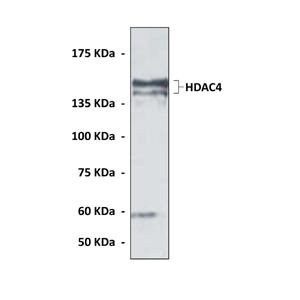Anti-HDAC4: Mouse Monoclonal Histone Deacetylase 4 Antibody |
 |
BACKGROUND Histone acetylation/deacetylation alters chromosome structure, affects transcription factor access to DNA, and regulates gene expression.1 Histone deacetylases (HDACs), as catalytic subunits of multiprotein complexes, deacetylate specific lysines in the tail residues of histones, resulting in the compactation of chromatin into a transcriptionally repressed state. HDACs have been shown to participate in a variety of cellular functions, including cell transformation, proliferation, senescence, differentiation, survival, and death.
Vertebrates express at least 18 distinct HDACs which have been grouped into four classes based on their similarity with yeast HDACs.2 Class I HDACs (HDACs 1, 2, 3 and 8) are composed primarily of a catalytic domain. These HDACs are ubiquitously expressed, localized to the nucleus, and serve as transcriptional repressors. Class II HDACs (HDAC 4, 5, 6, 7, 9 and 10) are larger proteins with an extended N-terminus extension involved in protein-protein interactions. These HDACs are further sub-classified into Class IIa (HDACs 4, 5, 7, and 9) and IIb (HDACs 6 and 10). In contrast to Class I HDACs, Class II HDACs display stage and tissue-specific expression. These HDACs are able to shuttle in and out of the nucleus in response to certain cellular signals.
Phosphorylation of these HDACs at two N-terminal serine residues by the calcium-calmodulin-dependent kinase (CaMK) creates a docking site for 14-3-3 proteins, resulting in their export out of the nucleus. HDAC11 is the sole member of the Class III HDAC family. The fourth class of deacetylases, called sirtuins (SIRT1-7), have catalytic domains similar to the yeast NAD+-dependent deacetylase Sir2. While serving as HDACs in yeast, in mammalian cells SIRTs are involved in the deacetylation of proteins other than histones, and are therefore not considered to be “classical HDACs.”
HDAC4 is a member of the class IIa histone deacetylase family. It is highly expressed in the brain, heart and in skeletal muscle. This protein does not bind DNA directly, but through transcription factors MEF2C and MEF2D. It seems to interact in a multiprotein complex with RbAp48 and HDAC3.3 It was demonstrated that HDAC4 plays an important role in regulating bone and muscle development as well as neuronal survival. HDAC4 has also been shown to be involved in cancer development,4 and could be a useful target for new anti-cancer therapies.
REFERENCES
1. de Ruijter AJ et al.: Biochem J. 370:737-49, 2003.
2. Yang X and Seto E: Oncogene 26:5310–5318, 2007.
3. Miska EA et al.: EMBO J. 18:5099-5107, 1999.
4. Wilson AJ et al.: Mol. Biol. Cell 19:4062-4075, 2008.
2. Yang X and Seto E: Oncogene 26:5310–5318, 2007.
3. Miska EA et al.: EMBO J. 18:5099-5107, 1999.
4. Wilson AJ et al.: Mol. Biol. Cell 19:4062-4075, 2008.
Products are for research use only. They are not intended for human, animal, or diagnostic applications.
Параметры
Cat.No.: | CC10016 |
Antigen: | Human HDAC4 N-terminal sequence |
Isotype: | Mouse IgG2b |
Species & predicted species cross- reactivity ( ): | Human, Rat, Mouse |
Applications & Suggested starting dilutions: | WB 1:1000 IP 1:50 IHC 1:100 ICC n/d FACS n/d |
Predicted Molecular Weight of protein: | 140, 145 kDa |
Specificity/Sensitivity: | Detects endogenous levels of HDAC4 protein in various cell lysates. |
Storage: | Store at 4° C for frequent use; at -20° C for at least one year. |
*Optimal working dilutions must be determined by end user.
Документы
Информация представлена исключительно в ознакомительных целях и ни при каких условиях не является публичной офертой








